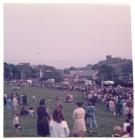Content can be downloaded for non-commercial purposes, such as for personal use or in educational resources.
For commercial purposes please contact the copyright holder directly.
Read more about the The Creative Archive Licence.
Description
Criccieth - The Lime Kiln.
Lime has been used in the making of mortar for building and for whitewashing cottages for hundreds of years. The burnt and crushed limestone was also used as fertiliser on the poor acidic soil of Eifionydd. On the Tithe Map of 1839, in the parish of Criccieth, seven “Cae’r Odyn” (Kiln Field) are named. They were usually near the farm house or a track. At Ynysgain Fawr farm the field was next to the beach, suggesting that the limestone was brought in by small ships. Further west ships would beach at Afonwen to unload limestones, culm and peat. These would be carried along the especially built cart track known as “Lôn Goed”. This was built between 1819 and 1828 by John Maugham, steward of the Talhenbont Estate to supply the farms along the way to Bryncir. This shows that it was an important industry. The only photographs, we have is of the lime kiln at Abermarchnad in Criccieth. Small wooden ships would take away slates from Traeth Mawr, later Porthmadog, and bring back limestone, coal and culm. The latter was small anthracite pieces which was mixed with clay into balls or brickettes. They would sail on to the beach and as the tide went out the cargo would be loaded on to horse and donkey carts. Further up from the kiln, where Tanygrisiau Terrace joins Lon Penpaled was a coal yard. After driving the cats away, who liked to be near the warmth, successive layers of limestone and coal were built up in the kiln on grate bars and a fire started. The process of producing the lime took 3-4 days, the fire having to be tended carefully. After removing the final product, often the children on the way to school would put a potato in the embers and eat them at lunch time. The area around the kiln must have been a terrible mess with the cart traffic, storage of the stones, coal and dust. When Criccieth started expanding and developing as a holiday resort, after the arrival of the railway, the Town Council tried for many years to purchase the land to get rid of the unsightly site but it was not until 1929 that the kiln was demolished and houses built along Beach Bank. The last worker at the kiln was Dafydd Williams from Chapel Terrace who was known as “Yr Hen Galchan” (Chalkie).






Do you have information to add to this item? Please leave a comment
Comments (0)
You must be logged in to leave a comment